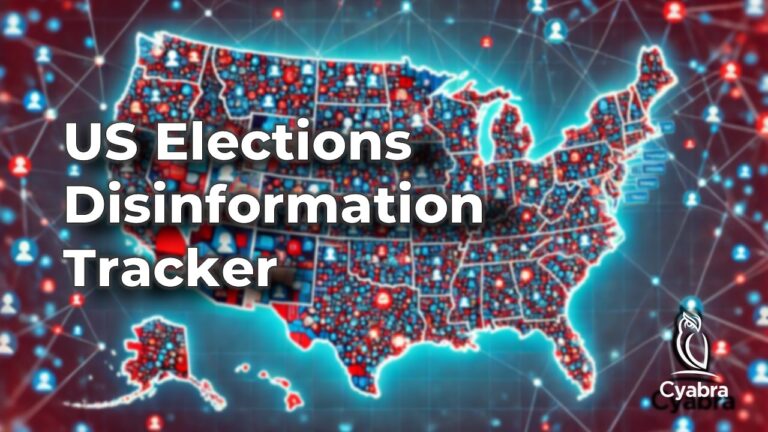Romania is heading for presidential elections… again.
Nationwide protests erupted shortly after the Romanian Constitutional Court annulled the previous election results. The court’s decision came in the wake of allegations of electoral misconduct linked to Russian influence.
While demonstrators continue to flood the streets, Cyabra’s analysis reveals that the manipulation tactics that plunged Romania into crisis are resurfacing again: Fake profiles, bot networks, and coordinated disinformation campaigns, many linked to Russia, have flooded discourse about the Romanian election, distorting public perception and fueling instability.
This operation was strategic, deliberate, and designed to undermine trust in democratic institutions while promoting far-right nationalist narratives.
Here’s what Cyabra uncovered:
TL;DR?
- 16% of the accounts discussing Romania’s election crisis on X were fake, with a potential reach of 20 million views.
- The fake accounts flooded conversations with anti-Western narratives, accusing the EU and NATO of orchestrating Romania’s political turmoil. Bot activity spiked ahead of key protests, amplifying nationalist and anti-democratic messaging.
- 34% of the engagement on a key post by far-right candidate Călin Georgescu came from fake profiles, artificially inflating his support.
- Influencers like Alex Jones unknowingly boosted narratives shaped by fake profiles, contributing to 447 million potential views.
When Fake Accounts Fan Real Flames
Cyabra analyzed online discussions that followed Romania’s annulled elections at the end of 2024 and the beginning of 2025. What emerged was a clear pattern: 16% of profiles participating in the conversation on X were fake, and they played an outsized role in pushing anti-government and anti-Western narratives.
These fake profiles focused on three key strategies:
- Boosting nationalist political figures like Călin Georgescu
- Undermining Western institutions such as the EU and NATO
- Hijacking hashtags to suppress accusations of foreign interference
These efforts were tightly coordinated and highly strategic, designed to deepen public distrust and political polarization.
In the picture: Posts from fake accounts spreading disinformation about Romania’s election on X.
Manufacturing Support for Far-Right Candidates
One of the primary goals of the fake profiles’ disinformation campaign was boosting the visibility and influence of Călin Georgescu, a far-right politician who was elected president in Romania’s annulled elections and has since emerged as a key protest leader.
Cyabra’s investigation identified Georgescu’s X account, @CG_Romania, as a central figure in the online unrest. Between December 15, 2024, and January 15, 2025, Georgescu shared over 50 posts, generating a potential reach of 264 million views – however, much of this online momentum wasn’t organic.
Georgescu claimed corruption and accused “oligarchic-globalist powers” of undermining Romania’s democracy. Cyabra’s analysis uncovered that 13% of the accounts engaging with Georgescu’s content were fake, strategically amplifying his narratives through coordinated comments, shares, and interactions. One of those key posts, with a 13 million potential views, was massively dominated by fake profiles, which accounted for 34% of the post’s engagement. Those fake interactions magnified Georgescu’s claims, presenting the illusion of widespread popular support. Fake accounts promoted pro-Georgescu, ultra-nationalist, and populist narratives and framed Georgescu as the sole leader capable of restoring freedom from foreign influence.
In the picture: X posts amplifying support for Călin Georgescu (@CG_Romania).
Hijacking the Narrative Against the West
The fake accounts didn’t just promote Georgescu; they also attacked Western institutions, accusing the EU and NATO of manipulating Romania’s election.
Common narratives included claims that Romania was a puppet state controlled by global elites, accusations that the EU orchestrated the election crisis to maintain influence over Eastern Europe, and calls for Romania to break away from Western alliances in favor of “true independence.”
By flooding hashtags like #călingeorgescu, #protest, and #interference, these fake profiles dominated online conversations, pushed anti-Western conspiracy theories, and suppressed authentic debate about Russian interference.
Cyabra’s analysis also revealed that bot activity surged in the lead-up to major protests in Bucharest. As tensions mounted offline, fake profiles ramped up online narratives that framed the protests as a patriotic uprising against Western control.
By tying the protests to themes of freedom, sovereignty, and resistance to elites, fake accounts ensured that nationalist, anti-Western sentiment was front and center as the demonstrations unfolded.
Cyabra also identified that posts by high-profile figures like Alex Jones and Shawn Ryan were infiltrated by fake profiles, with 21% of total engagement on their posts coming from inauthentic accounts, potentially reaching a combined 447 million views.
The posts themselves often echoed themes of globalist conspiracies, loss of freedom, and elite control, messaging that aligned with the disinformation campaign targeting Romania.
How Coordinated Disinformation Undermines Democracies
Cyabra’s findings highlight how coordinated disinformation campaigns strategically destabilize democracies by amplifying polarizing nationalist narratives, undermining trust in elections and Western institutions, and exploiting platform algorithms to maximize exposure.
The fake profiles’ tactics followed a clear, cohesive playbook:
- Amplifying polarizing narratives through populist, nationalist, and anti-Western messaging.
- Using the same key phrases, hashtags, and rhetoric across varied conversations to reinforce distrust.
- Deploying shared language like “globalist powers,” “elite,” and hashtags such as #Freedom and #NewWorldOrder
- Linking Romania’s crisis to broader conspiracy narratives seen in US and European elections.
These campaigns blend seamlessly into authentic conversations, making them difficult to detect – until their cumulative influence reshapes public perception.
Protecting Elections in the Age of Disinformation
Cyabra’s analysis makes one thing clear: coordinated digital manipulation is no longer an emerging threat; it’s an active force currently shaping political realities.
To protect democratic processes, governments must detect fake profiles early before they hijack conversations, monitor emerging narratives in real time to identify disinformation campaigns, and educate the public to recognize and resist coordinated manipulation efforts.
As we head into an era of AI-enhanced disinformation, safeguarding the integrity of elections will require vigilance, agility, and powerful detection tools.
Learn more about Cyabra’s capabilities in monitoring election discourse, uncovering fake campaigns, and identifying bot networks in real time.


